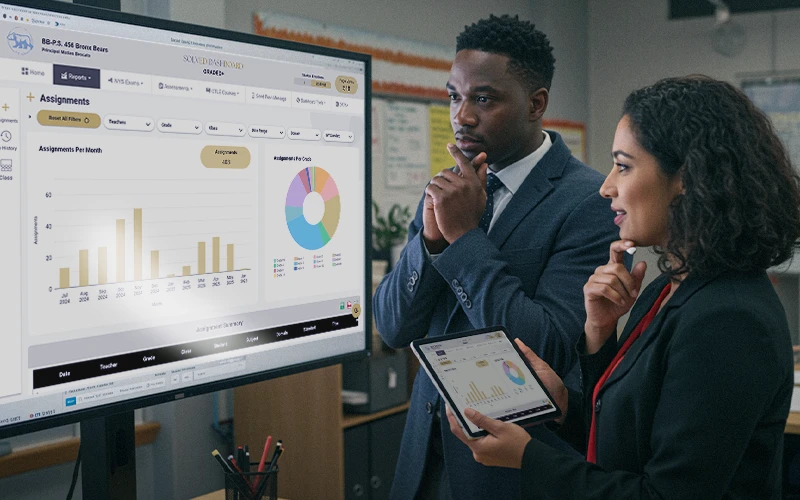
In today’s education landscape, schools generate vast amounts of data – from test scores and grades to attendance records, behavior logs, survey responses, and more. The challenge for educators and administrators is how to harness that data to drive meaningful improvements. Data-driven decision making in K-12 means using evidence from these data to guide teaching strategies, resource allocation, and school improvement initiatives. When done well, it can lead to higher student achievement, more efficient operations, and a culture of continuous improvement. In fact, research suggests that effective data use by schools and teachers can contribute to increased student learning and achievement . In this post, we’ll explore the why and how of data-driven decision making, with practical tips for school leaders to boost outcomes using data.
Why Does Data-Driven Decision Making Matter?
Imagine a doctor treating a patient without looking at vital signs or test results – it would be guesswork. Similarly, making educational decisions (about curriculum, interventions, etc.) without looking at data is like flying blind. Key reasons data-driven practices are important:
- Identifying Needs and Gaps: Data helps spotlight where students are struggling or excelling. For example, state test scores might reveal that math problem-solving scores dropped in 5th grade this year – that’s a signal to investigate and address a gap in the curriculum or teaching. Attendance data might show chronic absenteeism is high in 9th grade boys – indicating a need for engagement strategies for that group. Without data, these issues might be noticed late or not at all.
- Personalizing Instruction: At the classroom level, teachers can use data (like periodic assessment results) to differentiate instruction. If a reading assessment shows 5 students still decoding at an early level while others are fluent, a teacher can form a small group for targeted phonics practice. Data allows educators to move from one-size-fits-all to more tailored approaches based on evidence of what each student needs.
- Measuring What Works: Schools implement various programs – a new literacy curriculum, an afterschool tutoring program, a behavior incentive system. Data is how you measure if those are working. Perhaps you track that since adopting the new reading program, your 3rd grade reading proficiency went up 10%. Or maybe data shows no improvement, telling you that program isn’t effective or needs adjustments. This practice aligns with continuous improvement: try a strategy, measure results, refine or change course based on evidence. In one example, an Iowa elementary school used data teams to frequently analyze assessment results and could attribute a 15% rise in math proficiency to changes in instruction informed by that data (hypothetical illustration, but emblematic of data success stories).
- Accountability and Goal Setting: Setting quantifiable goals and tracking progress motivates staff and keeps the school focused. If your goal is “90% of students reading on grade level by year’s end,” you need data to know if you’re on track. Many schools now use data dashboards (like SOLVED’s School Data Dashboard) that consolidate key performance indicators (KPIs) – attendance, test scores, graduation rates, etc. – so leadership can monitor progress toward school improvement goals in real time. This not only helps in meeting state/federal accountability requirements, but also fosters a sense of accountability within the school to each other.
- Better Resource Allocation: Resources (time, money, staff) are limited. Data informs where to allocate them for maximum impact. For instance, if discipline data shows most referrals come from the playground, the principal might allocate funds to hire an extra recess supervisor or invest in playground training. If enrollment data shows a rise in English Language Learners (ELLs) struggling in science, perhaps you allocate budget for a bilingual aide in science classes. Data basically provides the rationale for decisions big and small, which can also help justify budgets to stakeholders.
The bottom line: using data leads to better decisions than relying on anecdote or intuition alone. As one education expert succinctly put it, “Without data, you’re just another person with an opinion.”
Building a Data-Informed School Culture

To effectively use data, a school needs the right culture and processes. It’s not just about the numbers, but how people collaborate around them. Here are elements of a strong data culture:
- Leadership Commitment: School leaders (principals, admin teams) should champion data use. This means not only asking for data in meetings but also providing time and support for staff to engage with data. When the principal frequently references data in decision-making, it sets a tone that this is “how we do things.” For example, a principal might start each staff meeting with a quick data spotlight – “Our on-time attendance rate improved to 95% this month, great job team!” – which keeps focus on data in a positive way.
- Collaborative Data Teams: Many schools establish teacher teams (often by grade or department) that meet regularly to review student data and plan responses. In these Professional Learning Communities (PLCs), teachers might bring assessment results or samples of student work, identify patterns, and share strategies. For instance, a 4th grade PLC might notice that across their classes, students struggled with a particular math standard. Together they can brainstorm a re-teaching strategy or share an activity one teacher used successfully. This joint problem-solving turns data analysis into action. It also makes it less intimidating – teachers support each other in interpreting data.
- Data Literacy Training: Not all educators are immediately comfortable with data analysis – and that’s okay. Schools that succeed in data-driven instruction often invest in training teachers on how to interpret different kinds of data (e.g., understanding percentile ranks vs. raw scores, making sense of standardized test reports) and how to use tools like spreadsheets or data systems. Some bring in coaches or utilize resources like Best Data Practices workshops to build these skills. A teacher doesn’t need to be a statistician, but they should feel confident reading a graph of student growth or spotting when a result is significant. As data use becomes more common, newer tools (including some with AI analysis support) are making it easier for educators to glean insights without crunching numbers manually .
- Time for Analysis and Action: An often overlooked aspect is simply giving teachers time to engage with data. This could be through built-in PLC times, occasional data days (some schools have an early dismissal day each quarter for data dives), or providing substitutes so teachers can have half-day data retreats. Without dedicated time, data either gets ignored or looked at superficially. During these sessions, it’s useful to have data displays ready (like a dashboard view of key metrics, or printed reports, etc.) so time is spent interpreting and planning, not scrambling to gather information.
- Safe, Non-Punitive Environment: Using data should not feel like “gotcha” or purely evaluative of teachers. It’s about helping students. Leaders should frame data conversations around growth and support. For example, instead of “Mrs. X’s scores are low – what is she doing wrong?”, a supportive data culture asks “These scores are lower than we hoped; what factors might be contributing and how can we help address them?” When teachers feel safe to honestly discuss data (even when it’s not glowing), they’re more likely to dig in and learn from it. Celebrating successes shown in data (“Ms. Y’s class made big gains in reading – let’s all hear what she tried!”) also balances the narrative so it’s not all about deficits.
Key Data Sources Schools Should Leverage
There are many types of data schools can use, each serving a different purpose. Here are some of the most common and how they inform decisions:
- Academic Achievement Data: This includes state test scores, benchmark assessments (like MAP or STAR), classroom grades, common formative assessments, etc. These data tell you how well students are mastering standards and skills. They can be analyzed at macro levels (e.g., overall proficiency rates in math) to identify subject-area strengths/weaknesses in the curriculum, or at micro levels (e.g., which specific test items had low success rates) to adjust instruction on particular concepts. Longitudinal academic data (tracking a cohort’s performance over years) can reveal if your interventions are working – say, your 3rd graders were low in reading, you implemented a new phonics program, and by 5th grade those students caught up to district averages.
- Growth Data: Beyond proficiency, growth measures (whether via student growth percentiles, value-added metrics, or simpler pre-to-post comparisons) show how much improvement students are making relative to their own starting points. High-achieving schools may not show growth if their top students stagnate, and struggling schools might show tremendous growth even if proficiency is still low. Growth data is great for highlighting effective teaching and learning even among students who haven’t hit an absolute benchmark yet. It helps ensure we pay attention to every student’s progress, not just how many hit a cut score.
- Attendance and Behavior Data: Attendance rates, chronic absenteeism percentages, tardies, behavior referrals, suspensions – these are key indicators of school climate and student engagement. They often correlate with academic outcomes. For instance, a student with chronic absences is at much higher risk of dropping out. Administrators can use this data for early warning systems (identifying students at risk due to absenteeism or behavior issues) and then intervene with mentors, parent conferences, or counseling. On a broader scale, trends like an increase in middle school truancy might prompt a school-wide focus on engagement or a new attendance incentive program. Many districts set specific attendance goals to improve, given its importance; data allows tracking if strategies (like home visits or texting parents) are moving the needle. Studies have shown schools implementing strategies based on attendance/behavior data see improvements in school climate and student safety.
- Survey and Perception Data: Don’t ignore qualitative data. Surveys of students, staff, and parents (on topics like school satisfaction, sense of safety, quality of instruction, etc.) can provide context that numbers alone won’t. If your data shows a plateau in middle school reading scores, a student survey might reveal many don’t feel motivated in English class – pointing to a need for engagement strategies or curriculum relevance. Teacher surveys might highlight professional development needs. Nowadays, many places do annual climate surveys and include those metrics in dashboards. They help ensure the “voice” behind the data is heard. For example, a school might see high bullying incident reports in data, but a student survey could reveal that certain areas (like the bus or locker room) feel unsafe – a very actionable insight.
- Financial and Operational Data: This might include budget allocations, class size numbers, technology usage stats, etc. While not directly about student performance, these data help with strategic planning. For instance, analyzing spending per student versus outcomes might show that certain investments yield more improvement than others. Or participation data in after-school programs might inform whether to expand them or try different offerings.
The key is integrating these data sources for a holistic view. A data dashboard can bring multiple data streams into one view – e.g., seeing side by side an academic metric, an attendance metric, and a behavior metric for the same student or cohort. This helps in identifying patterns and root causes. For example, you might notice that the students with higher behavior referrals also have lower test gains – indicating behavior issues are impeding learning, so focusing PBIS or counseling on those students could yield academic benefits too.
Tools and Technologies for Data Analysis

Handling data used to mean spreadsheets and manual graphs, which can be labor-intensive. Thankfully, there are many tools now to simplify school data analysis:
- Student Information Systems (SIS) & Data Dashboards: Most schools have an SIS that stores enrollment, attendance, grades, etc. Many SIS platforms have built-in reporting or analytics modules. Additionally, specialized data dashboards (like the one from SOLVED) can consolidate data from multiple systems into one user-friendly interface with visualizations. For example, a principal can log into their dashboard and see current attendance, recent assessment results, and even drill down to individual student profiles with one click. Interactive charts allow filtering by demographic group or time period. This puts powerful analysis at educators’ fingertips without needing to export and graph data themselves. If your district offers a data dashboard, take advantage of it and ensure teachers are trained to use it too for their classes.
- Collaboration & Data Warehousing Tools: Google Sheets or Microsoft Excel remain staples for many collaborative data tasks (like a grade-level tracking sheet of reading levels updated by each teacher). But more robust cloud-based solutions exist for large-scale data warehousing and analytics (e.g., PowerBI, Tableau, or education-specific ones like Illuminate, Schoolzilla, etc.). The choice often depends on district capacity and budget. The trend is towards centralized data systems that pull from SIS, assessment tools, learning management systems, etc. into one place. The more integrated your data, the easier it is to analyze comprehensively.
- AI and Advanced Analytics: As we head into 2025 and beyond, artificial intelligence is starting to play a role. Some modern data platforms include AI chatbots that can analyze data and answer questions. For example, SOLVED’s data dashboard mentions an “AI chat bot that analyzes data” – theoretically, you could ask in plain language, “Which subgroup had the most improvement this quarter?” and the AI would parse the data and give you an answer. Predictive analytics can flag students who are statistically at risk of not meeting a goal, early enough for intervention. While still emerging, these AI tools could drastically cut the time needed to surface insights, allowing educators to focus more on responding to data rather than crunching it.
- Data Walls and Visualization: Sometimes low-tech visualization works wonders in schools – like a “data wall” in the staff room where color-coded cards represent each student’s proficiency level or growth, updated each testing cycle. This makes data visible and keeps urgency high. Of course, privacy must be considered (e.g., use student ID numbers instead of names if publicly posted, or keep it in a staff-only area). But visually seeing the whole grade’s distribution can spark collaborative problem-solving. Digital equivalents exist too (interactive data walls in software), but the concept is to make data accessible and transparent to those who need it.
Whatever tools you use, ensure they’re user-friendly for educators. The fanciest analytics mean little if teachers find them too complex to use. Often a simple report that’s easily understood beats a convoluted dashboard with dozens of options. Get feedback from end-users (teachers, department heads) on what data they want to see and how.
Tips for Getting Started with Data-Driven Practices
If your school is just beginning to ramp up data use, here are a few tips to start:
- Start Small: You don’t need a fancy system or all types of data at once. Pick one priority – maybe improving reading outcomes. Gather the relevant data (recent reading scores), form a team, set a specific goal, and start the cycle of analysis and action for that area. Early success will build buy-in to expand to other areas.
- Ensure Data Quality: Nothing undermines data efforts like inaccurate data. Make sure attendance is being recorded correctly, tests are administered consistently, etc. Train staff on data entry and have someone (data coach or admin) double-check reports for obvious errors. Trust in the data is foundational.
- Ask the Right Questions: Data analysis should be driven by questions, as seen in resources like “5 Important Questions to Ask about End-of-Year Data”. Examples: Who is participating? (in advanced courses, in interventions), What trends do we see in attendance across the year?, Which programs have been most successful, and why?, How does this year’s data compare to prior years?, and importantly What are we proud of in this data? (identify and celebrate bright spots) . By posing questions, you give analysis a focus and avoid getting lost in the sea of numbers.
- Focus on Growth and Improvement, Not Blame: Frame data conversations around what we can do better rather than who’s at fault. If math scores are down, that’s a problem for all of us to solve, not just the math teacher. Keep a solution-oriented tone.
- Remember the Students Behind the Data: Quantitative data gives a big picture, but it should be paired with qualitative insight. If data shows a group underperforming, talk to those students or their teachers – get context. Perhaps those students have external challenges or engagement issues the numbers alone don’t show. Data should prompt deeper inquiry, including talking to students about their experiences. For every data point, there’s a child’s story; understanding both the data and the story leads to the best interventions.
Conclusion
Data-driven decision making is about empowering educators with information to make better choices for students. It moves us from hunches to evidence-based actions. In the age of accountability and high stakes, it also ensures no student falls through the cracks unnoticed. As one principal shared, looking closely at data helped their school find “bright spots of practice even when some data points seemed stagnant or challenging” – meaning they could learn from what was working even as they tackled what wasn’t.
Establishing a culture and system for effective data use doesn’t happen overnight, but every step – whether it’s setting up a school data dashboard, launching a weekly data meeting, or simply having teachers track and graph their students’ progress – is a step toward a more responsive and effective school. The year 2025 brings more technology and tools than ever to aid this process, from integrated platforms to AI analysis assistants, but the heart of it remains the human touch: educators asking good questions, collaborating on solutions, and keeping the focus on helping students succeed.
Your school’s data is a treasure trove of insights. Dig into it, act on it, and you’ll likely see the fruits in student outcomes. Data-driven success is ultimately student-driven success.





